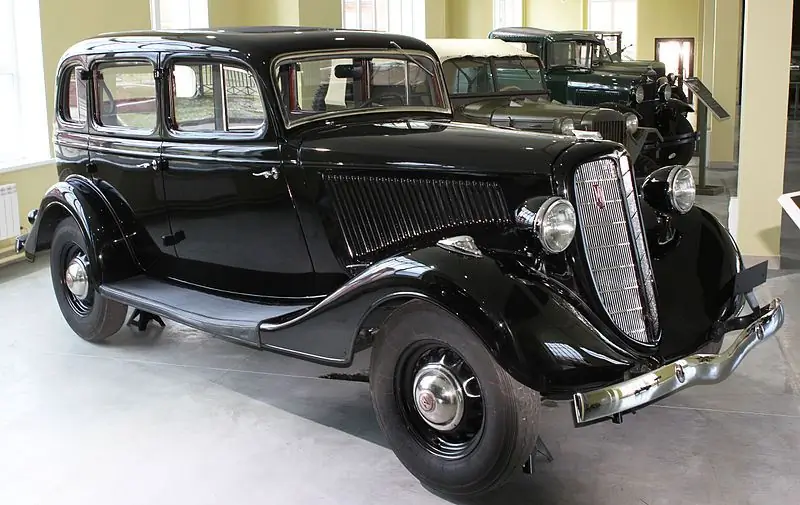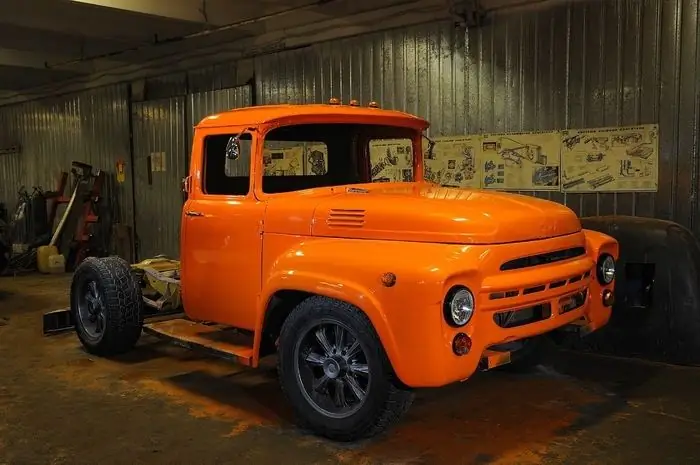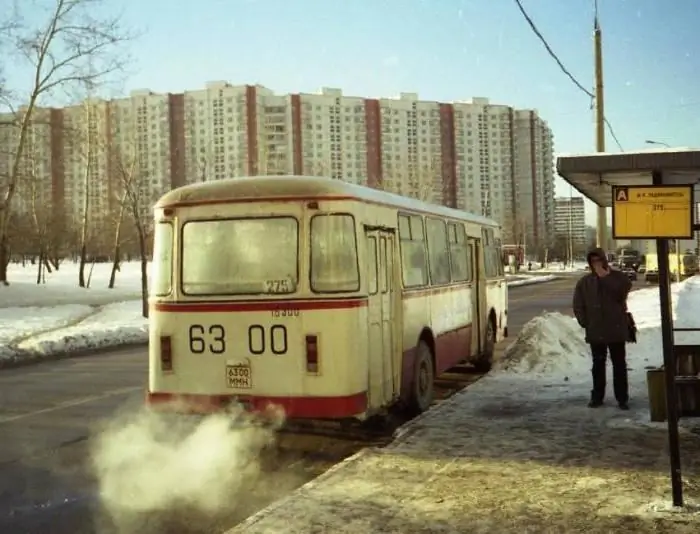2025 Author: Erin Ralphs | [email protected]. Last modified: 2025-01-22 21:14:13
At present, few people remember the LiAZ 677 bus, but it is enough to say “livestock truck” or “moon rover”, as people begin to understand and remember. Someone will remember this bus with a slight ironic smile, someone will smile more contemptuously.

But in most cases, these folk names and the buses themselves are happy as children. And it's very easy to explain. In these machines, childhood passed, as well as the youth of all those who were born in the Soviet Union and modern Russia. Let's try to look into the pages of the history of this legendary car and get to know it better.
These reliable and low-maintenance buses plied the city 30 years ago, but they have earned the right to be considered a true symbol of the bygone Soviet era. The history of LiAZ 677 is not just the history of the birth of the model, but a part of the history of everyone, a huge era.
He was ZIL, but became LiAZ. Model history
At the end of the 50s, the city bus ZIL 158, which actively worked on routes duringall the cities of a large country, prophesied a quick death. By that time, the car was already pretty outdated and urgently needed to be replaced. The design was archaic, and there were very few passengers.
However, these years are known for the strong and rapid growth of housing construction. So, in cities there were more and more inhabitants, and large settlements began to need large buses that would allow them to carry more passengers. Every day, tens and hundreds of thousands of people had to get to work, and most factories and industrial enterprises were at a sufficient distance.
Cars that were used as public transport could only accommodate up to 60 people. Cities grew, and such transport could not meet the needs. That is why LiAZ began to develop new large passenger buses to work on city routes.
So, spring, 58th year. In the small town of Likino-Dulyovo near Moscow, they began to produce buses. Production moved from the factory to them. Likhachev. The plant was very busy and simply could not ensure the assembly of the required volume of machines. In the winter of 1959, the first developments appeared to create a more spacious city bus.
In 1962, the first prototype, the prototype LiAZ 677, was produced.

In 1963, the model managed to earn its first reviews. The following year, a test drive of the bus was carried out in mountainous conditions. In the 65th year, the plant increased production volumes and became the largest enterprise that producedbuses.
After the LiAZ 677 design work was completed, the state commission gave the go-ahead to start production. And in the 66th year, buses began to arrive at the car factories of the capital. The first batch was assembled in the 67th, mass production was organized in the 68th. Initially, these machines worked only on the streets of Moscow. In other cities of a huge country, these models appeared later.
In 1971, the plant began mass production of the legendary LiAZ 677 bus.
Why "cattle truck"?
This nickname was not given to the car because of the quality of transportation. Everything is simple. The USSR has always helped fraternal Cuba in everything. And of course, buses were also delivered there. But in view of the fact that people there were valued very low, the car found another use. So, because the bus has a low threshold, it was very convenient for the transportation of cows. There was no need to create special ramps. The animal easily entered the LiAZ 677. The Cubans slightly changed the design - they cut off the roof due to weather conditions. Hence the "livestock truck".
Legend device
The model is considered to be the first real city bus, which was produced in the Union. Unlike previous projects, the novelty was not only designed for a larger number of passengers, but was also more comfortable.

The bus featured comfortable seats and a good heating system. Even in the wild frosts, some people managed to fall asleep very soundly in the cabin - it was so warm there.
Comfortable forcities
LiAZ 677 had an excellent suspension with automatic body position adjusters. From other buses, it was distinguished by a smoother movement. Over bumps and various road troubles, this model rode confidently. Excellent characteristics of elasticity and energy intensity of the suspension were achieved due to the fact that rubber-cord air cylinders were used in the design.
Capacity and geometry
The cabin accommodated up to 110 passengers, and 25 people could ride sitting. The seats are arranged in three- and four-row schemes. There was a fairly wide aisle between the rows of seats, which made these buses very comfortable and convenient for passengers.
The bus is 10530mm long, 2500mm wide and 3033mm high.
Body and interior
What was the LiAZ 677 - a model that is a symbol of happy days for many?
The body of the wagon layout had a supporting structure. Sections and parts of the body were connected to each other with rivets hidden under the lining, which served a decorative function.
The interior was lined with laminated plastic. Above the windshield there was a full house, where on the one hand they put the number of the route on which the car worked, and on the other hand - information about the route.
Lighting was provided by six fluorescent ceiling lights.

Hinged vents in each window allowed for natural ventilation of the interior.
The heating system deserves a special mention. She was an outflowhot air from engine cooling. The air duct ran along the left side of the body, and on the left side in front, immediately behind the driver's bulkhead, on a frosty day, people even fell asleep in the body.
Salon Features
The power unit in this car was located at the front to the right of the bus driver. The engineers decided that it would be very successful, and it did. This decision freed up a lot of space for passengers in the rear. And if it was necessary to repair the motor, for this it was not even necessary to go outside.
The rear axle took the bulk of the load. It had two wheels on the left and the same number on the right.

The passenger platform was located slightly below the cabin. And the salon could be reached on a gentle slope. To enter and exit the salon through the rear doors, the developers have provided two steps. There were three steps at the front, due to the fact that the bus has a front engine layout. Next to the cab, the cabin is also slightly raised.
Doors
So that the transport does not stand too long at bus stops, it has wide doors of four wings. The bus has two doors. The driver has a third door in the cab.
Driver's seat
Engineers sought to lead the project in such a way that the driver was very comfortable and functional. What can you say about the cab LiAZ 677? Its characteristics are informative and ergonomic. But at the same time, there is nothing superfluous. Dashboard was differentcharacteristic design for those years.
The driver's seat was sprung and allowed to adjust the height, angle of the backrest or pillows. The cabin and engine compartment were fenced off by a wall. In some modifications, a window was mounted, as on Ikarus. On such a window there was a window for passengers.
LiAZ 677 engine and fuel consumption
The car used a V-shaped unit ZIL 375. Many, with all the many advantages of the bus, considered this engine a big drawback. The 8-cylinder carbureted engine had 180 horsepower, but had huge appetites.
And even the fuel tank of 300 liters allowed to leave only 1.5 shifts. Drivers were required to refuel during breaks. But, despite such a huge expense, the model still went into production. Diesel buses did not yet exist, and there was a lot of gasoline. With 93rd gasoline, the unit burned about 75l / 100 km.
This figure today seems simply huge and unrealistic. Many drivers who worked on these machines called the motor an "elephant". This is because, in addition to huge appetites, he was also slow, and a loaded bus was difficult to climb uphill. But after the modernization of the LiAZ 677 bus, the technical characteristics improved slightly. First of all, we managed to create an engine for 76 gasoline, and we also managed to reduce consumption, which, according to the passport, became 54 l / 100 km.
There was one more feature of this unit - its overheating in summer. In winter, the engine froze. On hot days, the driver opened the engine compartment lid, and when winter came,the unit was insulated.
Transmission
The motor was paired with an automatic transmission. Here it should be said right away that this is the first bus with a checkpoint of this type.

Many drivers were immediately able to appreciate all the benefits that automation provided them. A two-speed gearbox made it possible to reach a maximum speed of 70 km / h.
Of course, this box was significantly different from modern models, but it was quite reliable and simple. It could be repaired very quickly.
Steering and brakes
The steering mechanics in the bus was equipped with a hydraulic drive. The brakes were dual-circuit, pneumatically actuated.
LiAZ 677 "Moscow"
The construction and design, as well as the characteristics, have not changed much over the entire period of release. However, in the 78th year, the production of the modernized LiAZ 677 M was launched. The gearbox, electrical equipment, and the brake system were finalized. The instrument panel has changed significantly.
Among the main differences of the new model is the interior. Also, the body was equipped with hatches on the ceiling. In addition, the bus has changed color. Now they were yellow.
We finished producing the modification "Moskva" in the 97th year.
Tuning
There are a lot of people who are addicted and interested in this technique - it's history.

There are even those who find these units of cars and restore them. Generally considered good luck.find at least an old LiAZ 677. Tuning it comes down to repainting and restoring its original appearance.
As a conclusion
There's a lot more to be said about this bus. There is a lot of interesting information related to it, a lot of interesting technical details. Today it is a rarity, and there are almost none left. This is an endangered species. But those who are truly addicted have recreated their favorite model in a computer game - LiAZ 677. "OMSI" is a bus driver simulator, and today the symbol of the bygone Soviet era we are considering is also available in it.
Recommended:
GAZ-11: photo and review of the car, history of creation, specifications and interesting facts

GAZ is the largest automaker that started manufacturing products in the city of Nizhny Novgorod. In the first years of its work, GAZ produced "Ford" products. For the realities of the Russian climate, the engine of this series of cars did not fit well. Our specialists solved the task, as always, quickly and without unnecessary troubles, taking as a basis (actually copying) the new GAZ-11 engine, the American lower-valve Dodge-D5
ZIL-pickup: description with photo, specifications, history of creation

ZIL-pickup car: history of creation, interesting facts, characteristics, features, modifications, photos. Pickup truck based on ZIL: description, restoration, tuning. Converting ZIL-130 into a pickup truck: recommendations, details, how to do it yourself
Wheel tractor MAZ-538: description, specifications, purpose and history of creation

Wheel tractor MAZ-538: description, history of creation, design features, photo. MAZ-538: technical characteristics, purpose, device, type of suspension, engine and gearbox
M-2140: photo and description, specifications, history of creation

"Moskvich-2140" (M-2140) is a typical rear-wheel drive sedan of the fourth generation from the "one and a half thousand" family. It was produced at AZLK (Moscow) for 13 years, until 1988. Immediately after the end of the Moscow Summer Olympic Games in August 1980, the number of such cars exceeded three million, and two years before the production of this model was discontinued, the next Moskvich-1500 SL set a new record and became the four millionth
Description, dimensions of "Daewoo Nexia" and history of creation

The Daewoo Nexia model is presented in a sedan body, the car belongs to the C-class. Daewoo Nexia gained its popularity in Russia and other CIS countries thanks to competitive prices. In addition to a comfortable interior and a fairly roomy trunk, the car has an excellent design. The car is in great demand in the world market. The dimensions of the Nexia are impressive, but not striking. Despite the considerable size, the car looks very organic and impressive

